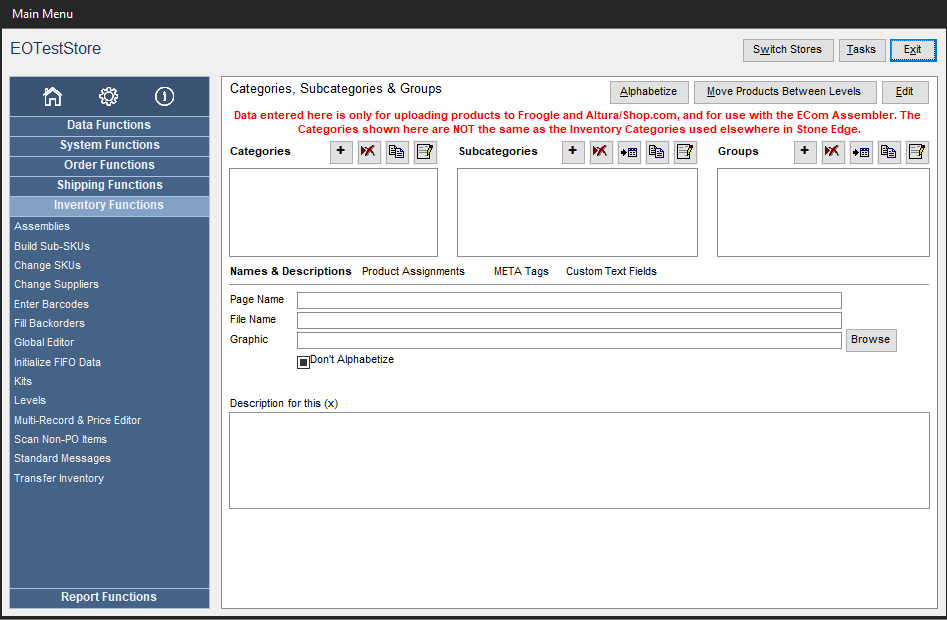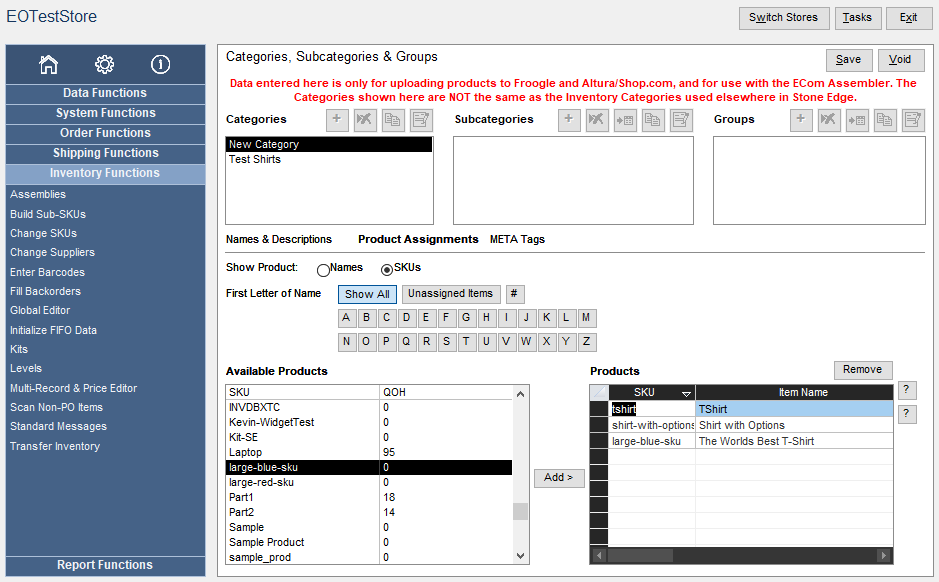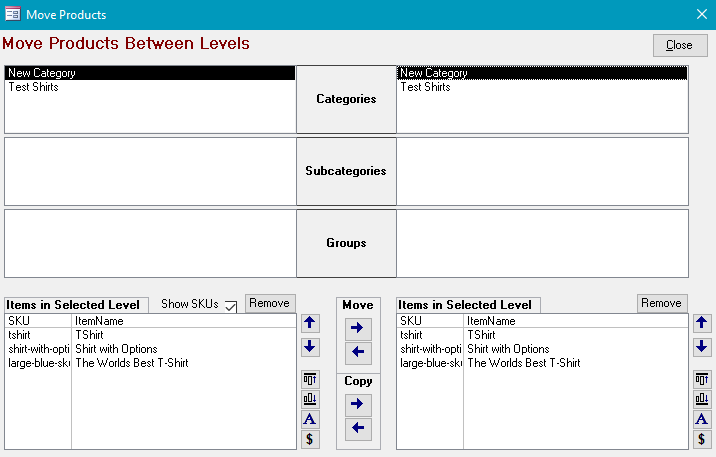Overview
- Levels refers to SEOM‘s ability to create up to a three-tiered hierarchy or “levels” to which products can be assigned, for the purpose of organizing a merchant’s product line.
- The three levels are Categories, Subcategories and Groups; Categories being the broadest classification group. The use of the terms “category” and “categories” in this article are not to be confused with the Category field on the Inventory record of a product, which can be used to identify the physical location of the product in a warehouse.
- The levels, categories, subcategories and groups, that are mentioned here can be used in conjunction with Froogle, Shop.com and Stone Edge Technologies’ ECom Assembler (Web catalog building program, no longer for sale). Froogle and Shop.com require that classification information is provided when product data is sent to them. Froogle only allows a single classification label for each product, while Shop.com accepts multiple level classifications per product, although only one is required.
- This feature is accessed by going to Main Menu > Settings > Inventory Functions > Levels
Description of the Screen

- At the top of the screen there are three sections that lists all of the entries defined in each of the three classification levels, Categories, Subcategories and Groups.
- At the lower portion of the screen there are several tabs, however the only one relevant to this discussion is the Product Assignments tab. The other tabs pertain to the ECom Assembler, which is outside the scope of this topic.
- It is only necessary to define the hierarchy of levels and assign products to them when using Shop.com or Froogle. No other data shown on the image above is required.
Alphabetize Button
- used to order the products on the product level pages for use with ECom Assembler
Move Products Between Levels Button
- can be used to relocate a product from one product classification to another
- opens the Move Products screen
Edit Button
- permits the user to alter the contents of the Names and Description, Page Links and META Tags tabs, which pertain only to the ECom Assembler
- click Save to retain the changes or Void button to abandon the changes that have been made
Close Button
- exit the Categories, Subcategories & Groups screen
Add Button
- create a new entry in the selected classification level: Categories, Subcategories, or Groups
Delete Button
- select an entry from the list in the appropriate section: Categories, Subcategories, or Groups, and click this button to permanently remove it from the system
Move Button
- select an entry from the list in the appropriate section: Categories, Subcategories, or Groups, and click this button to move it from one classification level to another
Copy Button
- select an entry from the list in the appropriate section: Categories, Subcategories, or Groups, and click this button to create a duplicate of that entry with a different name in the current classification level
Rename Button
- select an entry from the list in the appropriate section: Categories, Subcategories, or Groups, and click this button to create a change the name of that entry in the current classification level.
Defining Categories, Subcategories and Groups in SEOM
Categories
- Go to Main Menu > Settings > Inventory Functions > Levels. Refer to Figure 1.
- Click Add under the Categories section of the screen and enter a name for the new category.
- Click Save.
- Repeat steps two and three as often as necessary to create the broadest of classification labels to assign to products.
Subcategories
- Go to Main Menu > Settings > Inventory Functions > Levels.
- Click Add under the Subcategories section of the screen and enter a name for the new subcategory.
- Click Save.
- Repeat steps two and three as often as necessary to create subordinate classification labels to assign to products.
Groups
- Go to Main Menu > Settings > Inventory Functions > Levels.
- Click Add button under the Groups section of the screen and enter a name for the new group.
- Click Save.
- Repeat steps two and three as often as necessary to create the most detailed or specific level of classification labels that will be assigned to products.
Assigning Products to a Level
- Select the category, subcategory or group definition to which products will be assigned from the appropriate list at the top of the screen. Choose only one entry in one level at a time.
- Click Product Assignments.

Levels (Categories, Subcategories & Groups) screen – Product Assignments tab
- In the Show Product: section of the screen, choose a product from the list of Available Products. Select a radio button to list product the list by SKUs or Item Names. The contents of the list that will be produced can be controlled by selecting one of the following methods:
- Show All button displays all inventory products
- the number (#) or letter buttons can be used to filter the list of products that will be displayed, by those that start with a number or the specified letter
- Unassigned Items lists all products that are not currently assigned to a level
- Click Add to Page button.
- The selected product will now be listed in the Products section of the screen.
- To remove a product from a level, select it in the Products section and click Remove.
- The blue directional arrows will move the selected product up or down in the list of Products, which has no bearing in the context of this topic, as it relates only to the ECom Assembler.

- The images shown in this section of the topic show that the category, “New Category” is selected from the Categories section at the top of the screen. The Available Products list is filtered to display SKUs that begin with the letter “B”. Three products have been added to the category; T-shirt, Shirt-with Options, and Large-Blue-SKU. An example of creating a three-tiered hierarchy would have been to create a Category of “Clothing “, a Subcategory of “T-Shits” and lastly, Groups named “Color” or “Graphic”, etc.
Move Products between Levels
- Click Move Products Between Levels to open the Move Products screen, which is used to promote or demote a product to or from another classification level. The Show SKUs check box controls whether the products are listed by their Item Names or by SKU.

Move Products screen (Levels, Categories, Subcategories & Groups)
- Select a category, subcategory or group from the lists on the left-hand side of the screen. Then select a different category, subcategory or group in one of the lists on the right-hand side of the screen.
- Use the left or right directional arrows below the Move and Copy sections of the screen to place the selected product in the appropriate level.
- The other buttons at the bottom of this screen are used to change the sort order of the products in each classification level. The sort order is only applicable to the ECom Assembler, not Froogle or Shop.com. The ECom Assembler uses the sort order when it builds Web pages for each level and needs to know the order in which to list the items on each page.
- The example above shows that product “bed1” has been moved from the selected category, “New Category”, to the selected subcategory, “New Subcategory”, by selecting it from the list in the Items in Selected Level list at the bottom left-hand side of the screen and clicking the right arrow under Move.
